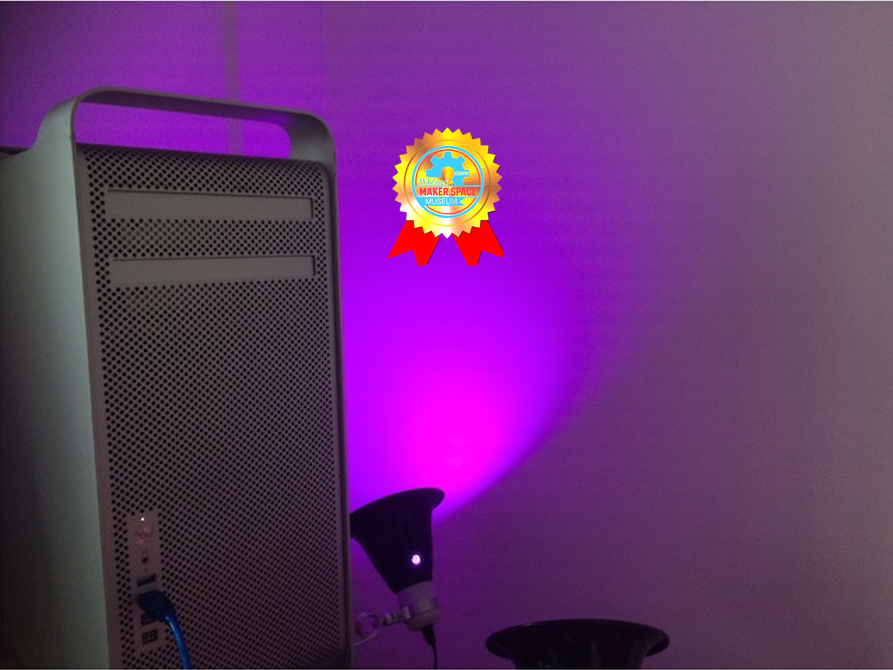
This project is a good example of DIY home automation.
The author explains how you can control LED lights from Philips using Arduino instead of Philips Hue Bridge (a kind of gateway solution to control the LED lights)
The author is introducing his project as below.
Why are we doing this? Because home automation systems can be quite rigid and expensive. By learning how to control the Hue from Arduino, you open the doors to a variety of custom made home automation projects that simply can’t be beaten by off-the-shelf components. If hacking things together just isn’t your thing, try these 8 fabulous Hue apps instead.
Get some idea about DIY home automation from this project!
Code
/*
Talking to Hue from an Arduino
By James Bruce (MakeUseOf.com)
Adapted from code by Gilson Oguime. https://github.com/oguime/Hue_W5100_HT6P20B/blob/master/Hue_W5100_HT6P20B.ino
*/
#include <SPI.h>
#include <Ethernet.h>
// Hue constants
const char hueHubIP[] = "192.168.1.216"; // Hue hub IP
const char hueUsername[] = "newdeveloper"; // Hue username
const int hueHubPort = 80;
// PIR
int pir = 2;
boolean activated = false;
// Hue variables
boolean hueOn; // on/off
int hueBri; // brightness value
long hueHue; // hue value
String hueCmd; // Hue command
unsigned long buffer=0; //buffer for received data storage
unsigned long addr;
// Ethernet
byte mac[] = { 0x74,0x69,0x69,0x2D,0x30,0x31 }; // W5100 MAC address
IPAddress ip(192,168,1,2); // Arduino IP
EthernetClient client;
/*
Setup
*/
void setup()
{
Serial.begin(9600);
Ethernet.begin(mac,ip);
pinMode(pir,INPUT);
delay(2000);
Serial.println("Ready.");
}
void loop()
{
if(digitalRead(pir) == 1){
Serial.println("activated");
// A series of four sample commands, which colour fades two lights between red and pink. Read up on the Hue API
// documentation for more details on the exact commands to be used, but note that quote marks must be escaped.
String command = "{\"on\": true,\"hue\": 50100,\"sat\":255,\"bri\":255,\"transitiontime\":"+String(random(15,25))+"}";
setHue(1,command);
command = "{\"on\": true,\"hue\": 65280,\"sat\":255,\"bri\":255,\"transitiontime\":"+String(random(15,25))+"}";
setHue(2,command);
command = "{\"hue\": 65280,\"sat\":255,\"bri\":255,\"transitiontime\":"+String(random(15,25))+"}";
setHue(1,command);
command = "{\"hue\": 50100,\"sat\":255,\"bri\":255,\"transitiontime\":"+String(random(15,25))+"}";
setHue(2,command);
// so we can track state
activated = true;
}
else{
activated = false;
Serial.println("deactivated");
//was activated, so send a single off command
String command = "{\"on\": false}";
setHue(1,command);
setHue(2,command);
}
}
/* setHue() is our main command function, which needs to be passed a light number and a
* properly formatted command string in JSON format (basically a Javascript style array of variables
* and values. It then makes a simple HTTP PUT request to the Bridge at the IP specified at the start.
*/
boolean setHue(int lightNum,String command)
{
if (client.connect(hueHubIP, hueHubPort))
{
while (client.connected())
{
client.print("PUT /api/");
client.print(hueUsername);
client.print("/lights/");
client.print(lightNum); // hueLight zero based, add 1
client.println("/state HTTP/1.1");
client.println("keep-alive");
client.print("Host: ");
client.println(hueHubIP);
client.print("Content-Length: ");
client.println(command.length());
client.println("Content-Type: text/plain;charset=UTF-8");
client.println(); // blank line before body
client.println(command); // Hue command
}
client.stop();
return true; // command executed
}
else
return false; // command failed
}
/* A helper function in case your logic depends on the current state of the light.
* This sets a number of global variables which you can check to find out if a light is currently on or not
* and the hue etc. Not needed just to send out commands
*/
boolean getHue(int lightNum)
{
if (client.connect(hueHubIP, hueHubPort))
{
client.print("GET /api/");
client.print(hueUsername);
client.print("/lights/");
client.print(lightNum);
client.println(" HTTP/1.1");
client.print("Host: ");
client.println(hueHubIP);
client.println("Content-type: application/json");
client.println("keep-alive");
client.println();
while (client.connected())
{
if (client.available())
{
client.findUntil("\"on\":", "\0");
hueOn = (client.readStringUntil(',') == "true"); // if light is on, set variable to true
client.findUntil("\"bri\":", "\0");
hueBri = client.readStringUntil(',').toInt(); // set variable to brightness value
client.findUntil("\"hue\":", "\0");
hueHue = client.readStringUntil(',').toInt(); // set variable to hue value
break; // not capturing other light attributes yet
}
}
client.stop();
return true; // captured on,bri,hue
}
else
return false; // error reading on,bri,hue
}
You can get all source code and all detail about the project from below link.
http://www.makeuseof.com/tag/control-philips-hue-lights-arduino-and-motion-sensor/
Tags : 201504, W5100, Arduino Ethernet Shield, home automation, web


COMMENTS